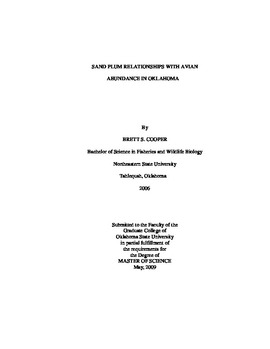| dc.description.abstract | I collected avian detections with point-counts and vegetation measures at 3 study sites in northwestern Oklahoma during 2007-08. Sand plum (Prunus angustifolia) thicket measures included height, stem density, area, age, and average thicket area. Herbaceous measures included percent grass, forb, and shrub cover; maximum herbaceous height; and vegetation species richness. I used a hand held-global positioning system (GPS) and a geographical information system (GIS) to digitize and buffer detections for affinity to sand plum. I used means and confidence intervals to relate vegetation measures with avian relative abundance. I used weighted means to describe habitat variables for avian species that had no meaningful relationships to sand plum. I sampled 42 independent points &#8805;4 times per year for 2 years from early May to mid June during 2007-08. Of the 42 points, 16 were grassland with no plum cover, 23 had sand plum cover of <50 %, and 3 had sand plum cover of >50 %. I grouped sand plum cover into 4 categories that included 0 %, 1-10 %, 11-20 %, and >40 %. I detected 51 avian species and identified 118 plant species. Species detections &#8804;30 m from a sand plum thicket ranged from 72.9 9.3 % SE for Bell's vireo to 16.4 6.6 % SE for western meadowlark. Bell's vireo mean detections were highest in the 11-20% sand plum cover category (1.2 1.3, 95% CI) and lowest in 0% sand plum cover (0.02 0.03, 95% CI). Grasshopper sparrow mean detections were highest in the 0% sand plum cover category (0.7 0.2, 95% CI) and lowest in the 1-10% sand plum cover categories (0.1 0.1, 95% CI). Western meadowlark mean detections were highest in the 0% sand plum cover category (0.4 0.2, 95% CI) and lowest in the 1-10% sand plum cover categories (0; 0.04 0.1, 95% CI). Bell's vireo, lark sparrow, and field sparrow were detected in the highest weighted mean sand plum cover (16.9 4.1, 14.0 3.3, and 12.2 2.8 % SE respectively) and northern bobwhite, grasshopper sparrow, and Cassin's sparrow were detected in the lowest weighted mean sand plum cover (4.2 1.9, 4.2 2.8, and 4.9 1.8 % SE respectively). | |
